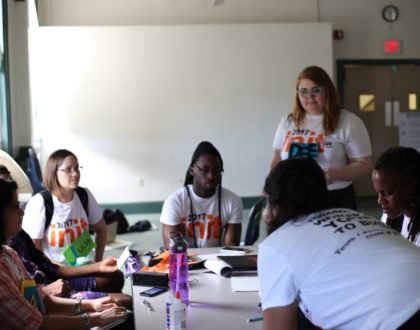Critical “staff practices” for SEL skill development

Rooted in best practices for SEL, InIt provides social justice education and leadership skill-building to Greater Boston high school youth. To accomplish this, SEL “staff practices” are a critical aspect of InIt’s program delivery. “Staff practices” support InIt’s program structure (as InIt is specifically designed to evolve SEL outcomes for the students we serve), as well as inform staff behaviors (as our professional team facilitates programming in a manner which role-models SEL standards). As the 2016-17 InIt program year has just ended, below are reflections on “staff practices” in each of the six SEL domains from Julia MacMahon, YW Boston’s Youth Leadership Program Manager.
1. Emotion Management
Throughout our program, we intentionally create space for “Real Talk” — a group conversation in which students are empowered to share their personal thoughts and experiences, while being emotionally supported and empathetically engaged by the InIt community. Staff has leveraged “Real Talk” at planned intervals to build a safe space for group processing, and have also relied on “Real Talk” to address of-the-moment issues. For example, Immersion Week took place shortly after the tragic 2016 shootings in Orlando. Processing this event of national and personal concern to our students in a safe, communal space was a productive way to channel complex thoughts and feelings, while strengthening the InIt community as a source of emotional support.
2. Empathy
InIt staff model empathy for students in countless ways throughout the program experience. However, we are currently re-working training for staff/volunteers to include more tools on “containment” — specifically, how to deliver high-impact curriculum to students without overwhelming youth emotionally. As a part of our emphasis on containment, we look forward to incorporating a group activity to close each InIt session — such as a calming breathing exercise — aimed at grounding our community in a sense of empathy.
3. Teamwork
A straightforward yet powerful example of how InIt engages in teamwork is that the group, from the start, develops and agrees upon “community norms.” These are reviewed at the beginning of each session, and serve as a collaborative ‘contract’ for group success throughout the duration of the program.
4. Responsibility
InIt staff recognizes that the journey of learning about social justice is lifelong, and believes that we are responsible for modeling continued engagement with these complex themes. For example: At InIt’s annual Social Justice Art Slam, both students and staff/volunteers are encouraged to present a creative work (in the form of visual art, music, drama, dance, or poetry) to our audience. In so doing, staff/volunteers not only share more of themselves with the youth we serve — but also show students that challenging, invigorating social justice work is an ongoing commitment.
5. Initiative
InIt staff meets with 2-5 students in small school delegation groups to strategically support the process of developing and launching “Community Action Projects” (CAPs). By providing individualized support to successfully complete these capstone projects, InIt staff motivate students to meet their goals, gently push students to develop their work further, and recognize (and celebrate!) youth achievement throughout the CAP process.
6. Problem-Solving
While InIt introduces “big issues” to students (such as immigration and health equity), we are also dedicated to providing youth with inspiring models of successful work being undertaken to counteract complex social injustices. For example, the Program Day focused on housing equity exposes the troubling legacies of redlining and other racist policies in Boston’s housing market. In the same session, students are also introduced to the Chinese Progressive Association — a partner agency which proactively to engages citizens in creating social justice-oriented solutions.
InIt is currently recruiting for the Class of 2018. Learn more about the program and how high school students can apply.
